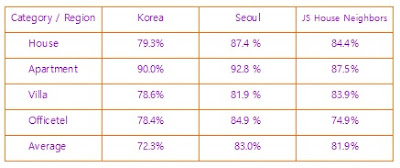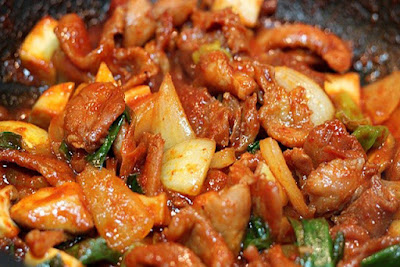Category
|
Area
(㎡) |
Sales Price
|
Jeonse
|
| |||
Key Money
|
Key
money
|
Monthly
Rent
| |||||
(KRW m)
|
(KRW
m)
|
(KRW
m)
|
(KRW
k)
| ||||
| Seoul |
56-65
|
200-1400
|
160-740
|
20-300
|
700-1000
| ||
80-85
|
260-1400
|
200-950
|
50-400
|
800-2000
| |||
| JS House Neighbors |
56-65
|
210-440
|
170-370
|
20-100
|
700-800
| ||
80-85
|
280-550
|
170-470
|
50-100
|
800-1400
| |||
* It depends on region and square meters of house.
1. Jeonse (lease on a deposit basis)
- Useful for those with cash on hand
- Key money (full deposit) lease (67%~75% of market price):
- Pay the balance when moving in
- Key money to give back in full at the expiry date (when moving out)
- Available for foreigner
- Tenant (lessee) has a right to live for contract periods (generally 2 years) without additional monthly payment
etc.) are applied for and paid by the tenant
* In cases of damage done to the property, it has to be fixed to the landlord's
standard
- Automatically extended if there is no expiration notice from landlord (tenant can declare suspension of contract before 3 months regardless of expiry date)
- Not compulsory to register in Court Registry Office
- No registration tax. No VAT
- Risks related to returning key money
pay the key money)
- Legal action by other creditors (Tenant may wait until all the procedures such
as court auction against the property is completed)
-> If the tenant is not prior over the other creditors, he/she may result in a big
loss.
-> Please refer to the below 5. to protect tenant's rights and secure senior
lien against the property for the key money amount given
- Landlord may ask to increase the key money. If you agree, you should check
the information and consider market price of the property.
-> Check the other parties claim or lien (see the below 5. c))
-> If the renewed total key money is high compared to market price, consider
the renewal of contract.
* Even though the highest increase ratio is 5% by law, landlord can ask to
increase much more according to market price. If you don't accept, you
may find other house.
-> Keep the old contract and new contract after stamping for certifying contract
date at the Dong office
* The main reasons why Jeonse is popular
a. Landlord can own a house by his/her small amount of seed money
b. Real estate price expects to increase
c. Landlord can make a return by investing the deposit money
d. Tenant can use the house at low cost
2. Wolse (lease on monthly rent basis)
- Useful for those with less cash… (but still a sizeable amount)
- Key money (deposit) of 10~20 months rent
- Pay the balance when moving in
- Pay rent monthly
- Key money to give back in full at the expiry date (when moving out)
- Less payback risk of key money
- Rent is more expensive than financial cost on deposit of Jeonse
- Rent is negotiable with landlord
a. Landlord prefers a monthly rate comparing with expected financial gain from
Jeonse due to low interest rate
b. Not easy to find investment of blue chips with key money due to economic
recession
c. Big amount of key money is burdened to tenant.
3. Kalse (full payment up front without key money)
- A kind of variation of Wolse
- The rent is paid for the entire period of the lease before the tenant moves in
- The lease period is usually for a minimum of 1 year and a maximum of 3 years
- Clearly stipulate acceptable reasons for early termination as well notice and refund procedures in the lease agreement to avoid having to pay a penalty or losing the entire pre-payment
- The usual notice period of 60 to 90 days.
4. Mixed with Jeonse and Wolse
- Increasing trend on mix of Jeonse and Wolse, especially by retired baby boomers expecting rent income due to decreased interest income by low interest rate
- Key money (deposit) of approximately 70 months rent
- Key money to give back in full at the expiry date (when moving out)
- Rent is based on the key money of Jeonse, i.e. 6%~10% of difference between key money of Jeonse and Wolse per annum.
Wolse key money: KRW80,000,000
Rent (7%): Monthly KRW700,000 (120,000,000 x 7% / 12months)
5. How to protect tenant's rights against court auction
1) Court Auction
- Parties related to owner can file court auction according to proper rights such as court judgement or overdue of loan
- Court notifies the commencement of auction process to all the related parties
- Tenants should file their own rights to the court to receive dividend after final bidding
- Priority against the other parties depends on countervailing date including stamp date on Jeonse, i.e. the countervailing date (see the below 3) ) must be earlier than other registration date in the Court Registry Office. Then tenant has prior rights of dividend against the other creditors.

- Everybody can access information such as ownership of property, legal actions against the property, collateral security established to the property, etc. from Court Registry office
- Cautiously check the above information, especially owner, legal actions and collateral registration (senior lien)
contract completion because the information is written by Korean).
3) Tenant protected by law (Protection under Housing Lease Act)
- A foreigner need to register in immigration office as a resident in Korea and then the Alien Registration Card must be updated upon the place of sojourn as soon as possible
- Need stamp certifying definite date from Dong office (community service center)
- Occupy (live in) the leased house
should not move out until the key money pay back to you.
4) Establishment of leasehold
- File the leasehold to Court Registry Office
- Landlord must agree the establishment of leasehold
* For the other information, please refer to http://www.asiaoptions.org/housing-in-korea/,
https://www.angloinfo.com/south-korea/how-to/south-korea-housing-renting-accommodation,
http://blog.thearrivalstore.com/life-in-korea/korean-rent-apartment-in-korea/








































